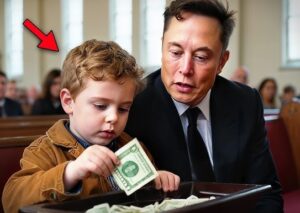On a seemingly ordinary Sunday, a simple drive turned into a profound moment of inspiration for Elon Musk, the visionary behind Tesla, SpaceX, and Neuralink, and his young son, X Æ A-12, affectionately known as X. What began as a casual outing led to an encounter that would shift perspectives, spark a movement, and remind the world of the power of small, selfless acts. This is the story of how a child’s dollar, given with pure intent, ignited a ripple effect of kindness, reflection, and innovation.
A Quiet Stop at a Church with a Blue Door
The story unfolds during a leisurely drive through a small town, where X, with the curiosity and insistence only a child can muster, asked his father to stop at a modest church with a striking blue door. Intrigued by his son’s request, Elon obliged, and the two entered the sanctuary, unaware that this moment would leave an indelible mark.
Inside, the atmosphere was warm yet unassuming. The congregation, a mix of locals from all walks of life, gathered for a humble service led by a pastor whose sermon centered on the transformative power of small gifts. The message was simple but resonant: even the smallest act of generosity, given with a pure heart, can create a chain reaction of good. As the offering plate made its way through the pews, X, without hesitation, reached into his pocket and placed his only dollar into it.
Elon, watching his son’s quiet act, was initially puzzled. Later, as they drove away, he asked X why he gave away his only dollar. The boy’s response was as profound as it was simple: “Because I don’t need it right now. But maybe someone does. And God can make it go places I can’t.” The words struck Elon with a force he hadn’t anticipated, leaving the tech titan momentarily speechless.
A Child’s Wisdom Sparks Deep Reflection
For a man accustomed to solving problems through innovation, engineering, and grand ambition, X’s words offered a different kind of challenge—one rooted not in technology or profit but in the intangible values of kindness, dignity, and human connection. Over the days that followed, Elon found himself haunted by the moment. X’s conviction, delivered with the unfiltered clarity of a child, prompted a period of introspection unlike any he had experienced before.
X, meanwhile, continued to embody the spirit of giving in his own way. At home, he created colorful drawings of what he called a “House of Warm”—a place where people without homes could find not just shelter but also beauty, comfort, and care. His sketches, filled with vibrant hues and imaginative designs, depicted spaces with cozy beds, warm lighting, and gardens where people could feel at home. To X, the “House of Warm” was more than a concept; it was a vision of dignity for those in need.

Elon, moved by his son’s creativity and compassion, began to see the potential for something tangible to emerge from X’s ideas. The billionaire, known for turning bold visions into reality, started to envision a new kind of shelter—one that prioritized not just utility but also the emotional and psychological well-being of its residents. This was uncharted territory for Musk, whose career had been defined by rockets, electric cars, and neural interfaces. Yet, inspired by X, he embraced the challenge with the same fervor he brought to his technological endeavors.
From Vision to Reality: The “House of Warm”
Elon’s first step was to return to the church with X, seeking to understand the community and its needs more deeply. The blue-doored sanctuary, once a fleeting stop, became a place of connection. The pastor and congregation welcomed them warmly, and over time, Elon and X built relationships with the people there. They learned about the struggles of the unhoused in the area—stories of loss, resilience, and hope that grounded their vision in reality.
Drawing on X’s drawings and the insights gained from the community, Elon assembled a team of architects, designers, and social workers to bring the “House of Warm” to life. Unlike traditional shelters, which often prioritize function over form, these spaces were designed to be inviting and restorative. The plans included natural light, communal areas for connection, and small touches like artwork and greenery to foster a sense of belonging. The goal was to create environments where residents felt valued and empowered, not just housed.
The project also incorporated sustainable technologies, a nod to Musk’s expertise. Solar panels powered the facilities, and modular designs allowed for scalability, making it possible to replicate the model in other communities. But at its core, the “House of Warm” was about more than innovation—it was about embodying the spirit of X’s dollar, a small gift meant to go places he couldn’t.
The Ripple Effect of a Single Dollar
As the first “House of Warm” took shape, the impact of X’s initial act began to ripple outward. The church community, inspired by the project, organized their own initiatives to support the unhoused, from food drives to mentorship programs. Strangers, touched by the story of a child’s generosity, began contributing in their own ways—some with donations, others with time and skills.
Elon, too, found himself changed. The man who once measured success in terms of market share and technological breakthroughs began to see the value of intangible outcomes: a smile from a shelter resident, a drawing from X, a moment of connection in a church pew. For someone whose life had been defined by relentless forward motion, this pause to reflect on kindness and community was transformative.
X’s dollar, though small in monetary value, became a symbol of something far greater. It reminded those who heard the story that generosity doesn’t require wealth or grand gestures—just a willingness to give what you can, when you can. The “House of Warm” stood as a testament to this idea, a physical manifestation of a child’s belief that one small act could change the world.
A Lesson for Us All
The story of Elon Musk and X’s Sunday at the blue-doored church is more than a heartwarming anecdote; it’s a call to action. In a world often dominated by division, competition, and self-interest, X’s simple act of giving offers a powerful reminder of what’s possible when we prioritize others. His dollar didn’t solve world hunger or end homelessness, but it sparked a chain reaction that touched lives in ways he could never have imagined.
For Elon, the experience was a humbling detour from his usual path. It challenged him to think beyond innovation for innovation’s sake and to consider how his resources and influence could serve a higher purpose. The “House of Warm” is just the beginning, with plans to expand the model to other cities and countries, each shelter carrying the spirit of X’s vision.
As we reflect on this story, we’re invited to consider our own small gifts. What can we give, no matter how modest, to make a difference? How can we, like X, trust that our contributions—however small—can go places we can’t? The answers may not always be grand, but as this story shows, they don’t need to be. Sometimes, a single dollar and a child’s faith are enough to start a revolution of kindness.


